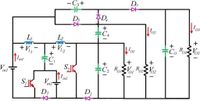A novel high step-up converter, known as a non-isolated multiport dual-input three-output (DITO) DC–DC converter, has been developed to significantly enhance the efficiency of renewable energy systems. This innovative design presents enhanced voltage gain across its outputs, ensuring lower loss and reduced voltage stress on critical electronic components.
Traditional energy sources are waning due to environmental concerns and finite resources, prompting a renewed interest in renewable systems like photovoltaic (PV) panels and fuel cells (FCs). These alternative energy sources typically generate low voltage output, necessitating multi-port converters to boost voltage and power levels for practical applications.
The proposed converter stands out by offering high voltage gain at each of its three outputs—45 V, 83 V, and 144 V—from a dual-input power supply of 20 V. It operates at a frequency of 50 kilohertz with a duty cycle of only 0.4, thereby minimizing losses. Compared to traditional methods that require steep switching duty cycles and can lead to heightened input ripple current, the DITO design reduces stress on both the power switches and diodes.
The DITO converter comprises two power switches, five capacitors, five diodes, and two inductors, showcasing a streamlined architecture that simplifies design and construction. Experimental results affirm the theoretical viability of the proposed architecture—average currents measured from the inductors are about 3.35 A and 3.43 A, respectively, supporting the efficient energy management inherent in this system.
Another significant aspect of the DITO converter is its operational flexibility, allowing more efficient energy distribution across its outputs. The prototype resulted in stable voltage outputs under variable load conditions, a crucial factor in real-world applications. The maximum recorded voltage and current through switch S1 was 20V and 24A, while for switch S2, these measurements were 45 V and 24 A. Such data underscore the converter's robust capability in managing high voltage processes while maintaining electrical integrity.
The research team, led by Bahadori et al., conducted comprehensive comparative studies, demonstrating that the DITO converter outperforms many existing multi-input, multi-output converters in terms of component count, efficiency, and reduced voltage stress on semiconductors. This enhanced performance is pivotal for applications in renewable energy systems such as solar panels and fuel cells.
Moreover, the innovative DITO converter supports the expansion of sustainable energy solutions, enabling the transition towards greener alternatives. Future work will focus on herding further optimizations, aiming to scale the converter for broader applications in the energy sector.
Given the current global push towards renewable resources due to climate concerns and the diminishing availability of fossil fuels, the feasibility of such advanced converters is paramount. The DITO converter underscores the potential for significantly improving the integration of renewable sources into energy grids without incurring dramatic increases in cost or complexity.
In this pivotal development, Bahadori and colleagues not only propose a converter with high voltage efficiency but also lay groundwork for future advancements in converter technology that could revolutionize energy distribution. The advancement aligns with the global movement toward cleaner energy solutions and showcases a promising avenue for meeting future energy demands efficiently.




